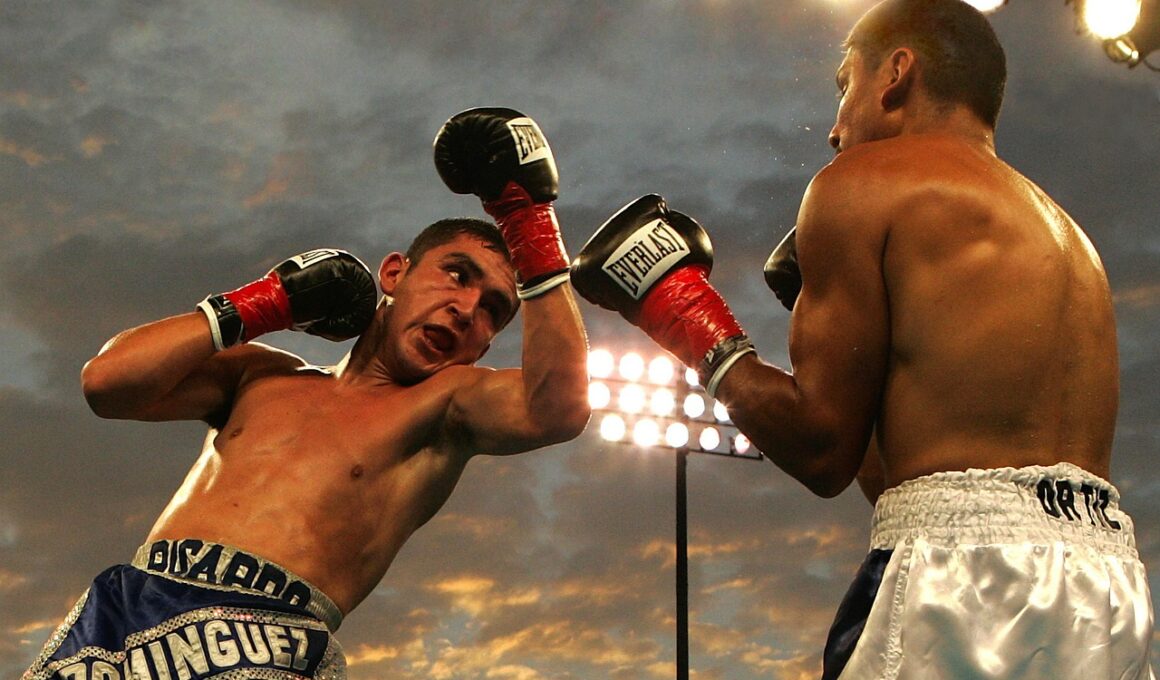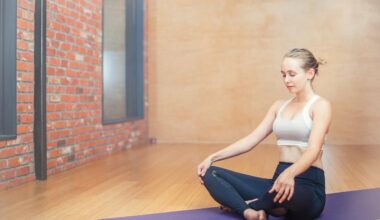Boxing Fitness Techniques: Jab, Cross, Hook, and Uppercut Explained
Boxing fitness combines physical training with boxing techniques, enhancing both strength and cardiovascular fitness. Among the core techniques, the jab serves as a fundamental part of any boxer’s arsenal. This punch is primarily used for maintaining distance and gauging an opponent’s reach. It’s a quick punch made with the lead hand, designed to disrupt an opponent’s rhythm and set them up for more powerful strikes. Practicing the jab consistently improves timing and accuracy. Furthermore, coaches emphasize the importance of proper technique, advising boxers to keep their elbows in and rotate their fists appropriately. The jab helps keep opponents at bay while providing openings for follow-up punches. Incorporating drills such as shadow boxing with a focus on the jab enhances muscle memory and performance to allow better transitions into combinations. In addition to improving overall stance, it positions boxers for offensive and defensive maneuvers. Integrating the jab into a workout ensures a solid foundation, building strength and confidence, while allowing practitioners to engage in sparring sessions. This makes the jab an essential tool for those looking to advance their boxing fitness journey as well as understanding strike basics.
The next crucial technique in boxing fitness is the cross. Typically delivered after a jab, the cross employs the dominant hand and is known for its power. This straight punch darts across the body, allowing a quick counter to opponents’ defenses. Boxers should aim to pivot their back foot and rotate their hips while executing the cross, as generating power from the core is vital. When trained correctly, the cross can often result in knockdowns or significant damage due to its strength. Engaging in partner drills focusing on the one-two combination—jabbing then crossing—establishes a rhythm for throwers. Focus pads and heavy bags serve as ideal tools for honing the cross, providing resistance and feedback. Proper positioning is essential, as throwing too wide can leave boxers vulnerable. Consistent practice leads to increased accuracy and timing, allowing boxers to strike at peak moments in a fight. Additionally, understanding when to throw this powerful punch can dictate pacing throughout each round. When integrated into a workout, the cross enhances the overall boxing fitness routine and boosts striking confidence.
Understanding the Hook Technique
Another dynamic technique is the hook, a circular punch aimed at an opponent’s head or body. Effective hooks emerge from an engaging stance and require swift movement, positioning, and timing. This punch takes both skill and practice to master and often catches opponents off-guard. The hooks can lead to knockouts if delivered correctly, especially if they target vulnerable areas such as the jaw or ribs. Boxers utilize this punch to close distance, making it a vital tool during exchanges. Proper body mechanics include pivoting the lead foot and rotating the torso while keeping the elbow high. Regular practice via heavy bags or sparring with a partner sharpens the effectiveness of hooks. Many trainers advise against dropping the hand after throwing a hook, highlighting the importance of returning to guard position quickly. Including hooks not only diversifies a boxer’s striking skills but also enhances reflexes and adaptability during bouts. Boxers can benefit from integrating hooks into their training sessions, ensuring optimal punching technique and increasing the likelihood of scoring during fights. With dedicated effort, hook integration brings significant advantages in boxing fitness and competition.
The uppercut, although less frequently used than other punches, is an essential aspect of boxing fitness. This upward punch targets an opponent’s chin or jaw and can turn the tables unexpectedly. Learning to throw an uppercut effectively requires ample practice and understanding of biomechanics. Boxers need to maintain a low center of gravity for stability while generating power through the legs and hips. The technique involves bending the knees slightly and then thrusting the fist upward in a fluid motion. A well-timed uppercut can lead to powerful combinations, especially when used after a jab or a hook in rapid succession. Many boxing workouts incorporate uppercut drills into the routine to enhance performance and striking capability. Engaging with partners helps simulate real-fight scenarios, making fighter responses more instinctual. Coaches also recommend utilizing a heavy bag to develop uppercut strength and precision. This particular technique can surprise opponents who are more prepared for straight punches. Therefore, consistently including uppercuts within training helps boxers maintain diverse and effective striking techniques while ultimately elevating overall boxing fitness and competitive readiness. Moreover, creativity in combining punches benefits sparring effectiveness.
The Integrated Approach
Incorporating boxing techniques into fitness workouts emphasizes not just the development of striking skills, but overall physical conditioning. It’s essential to develop a well-rounded training regime that focuses on strength, speed, endurance, and technique. Group fitness classes centered around boxing provide an engaging atmosphere where participants can thrive. These environments foster camaraderie and motivation, whether participants are seasoned athletes or beginners. Classes can vary greatly, focusing on bag work, partner drills, or incorporating conditioning circuits involving jumping rope, shadow boxing, and strength-building exercises. Structuring workouts around these components ensures participants develop physical attributes conducive to effective boxing performance. Coaches commonly stress the importance of focusing on form and technique over raw speed during exercises. Learning to punch effectively while maintaining proper stance offers long-term benefits in striking and movement capabilities. Furthermore, studying technique also empowers individuals to perform better in group settings. A community approach helps individuals find accountability, enhancing consistency and attendance rates. Regular attendance to boxing fitness classes will undoubtedly lead to improvements in stamina and striking accuracy, thereby benefiting all participants significantly.
Boxing fitness isn’t solely limited to technical execution but must also encompass mental wellness and strategy. Intelligent decision-making plays a vital role in successful boxing performance and overall fitness. Boxers need to remain calm under pressure, thinking quickly to execute strategies effectively. Develop a clear understanding of timing, distance, and adaptability to create openings against opponents. Mental fitness synergizes with physical training to create a comprehensive boxing approach, instilling confidence and discipline among practitioners. A significant aspect is visualizing various techniques during training sessions. Boxers can rehearse specific scenarios, preparing their reactions while refining striking techniques in their minds. This mental practice enhances their abilities, ensuring that once faced with real opponents, they can apply learned strategies flawlessly. Beyond physical attributes, mental preparation can spur significant growth and improvement during workouts. In addition, a positive mindset fosters resilience and perseverance, ultimately contributing to a boxer’s success in competitions. Thus, integrating the mental components into boxing fitness classes creates well-rounded athletes ready to face challenges, increase performance levels and build foundational strengths relevant to the sport.
Conclusion: The Path Forward
In conclusion, mastering boxing fitness techniques like jabs, crosses, hooks, and uppercuts is integral to both skill improvement and conditioning. Engaging in these core techniques maximizes the benefits of boxing-focused workouts and creates a balanced athletic approach. Participants in boxing fitness classes not only increase strength and endurance but also sharpen their reflexes and strategy. As practitioners become more experienced, they can broaden their skill sets to incorporate defensive techniques, combinations, and footwork. Progressing through various skill levels leads to greater enjoyment and satisfaction in their training. Consistently implementing the outlined techniques into regular workouts fosters solid technique and deeper understanding of boxing at any level. For those passionate about enhancing their boxing fitness journey, pursuing ongoing practice and participation in classes unlocks countless benefits. As they revisit, refine, and enhance their skills, boxers can cultivate meaningful connections with fellow enthusiasts. In essence, boxing fitness becomes a lifestyle choice that encourages personal growth and physical well-being, fostering a positive community culture. Overall, boxing fitness promotes an empowered approach to training, equipping individuals with essential skills and mindset necessary for success.
Further Learning Opportunities
Whether seeking beginner courses or advanced training sessions, pursuing additional learning opportunities is vital for growth. Many local gyms and fitness centers offer specialized boxing workshops focusing on various techniques or performance aspects, alongside practice-based classes. Online tutorials and resources provide a wealth of information on refining and understanding techniques. Additionally, diving into the history and fundamentals of boxing promotes informed practice, offering insights into the evolution of styles and approaches. Attending local boxing events can also provide inspiration and allow individuals to observe various styles. Furthermore, connecting with experienced trainers opens doors to alternative methods, leading to informed training decisions. By taking advantage of available resources, practitioners can actively foster their boxing fitness journeys while ensuring optimal performance enhancements. This ties deeply with building the necessary community support, enabling aspirants to surround themselves with like-minded enthusiasts passionate about the craft. Lastly, maintaining motivation and a keen desire to continually enhance one’s boxing technique facilitates ongoing personal and athletic development. Such commitment only amplifies the overall benefits of boxing fitness for individuals looking to prosper in the sport.


